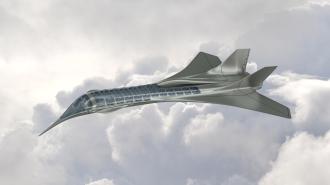The Millennium Falcon may fly faster than the speed of light in space, but in an atmosphere — the layer of gasses surrounding a planet — the smuggler’s spaceship wasn’t much faster than a passenger jet. It turns out, entering the atmosphere at super speeds introduces a host of problems. Researchers are working to solve big design challenges of hypersonic flight with a surprisingly small wind tunnel.
Imagine hopping on a plane for your morning commute and traveling coast-to-coast in about 30 minutes, or jetting off to outer space for a honeymoon vacation. Mechanical engineer Chris Combs says that may not be too far in the future. He is working on the effects of hypersonic speeds on aircraft.
In hypersonic flight, aircraft, rockets, or missiles can reach speeds faster than 4,000 miles per hour through the atmosphere. While military uses may be the first obvious application, Combs says that hypersonic travel has a role in civilian travel, too — even space tourism.
“This is a problem that has to be solved for space access and making space flight — and even space tourism — a very regular thing. To do that well, you’ve got to understand hypersonic, because anything that comes back to Earth, (or) anything that lands on another planet is going to deal with the hypersonic environment,” he says.
“You could have a dinner reservation across the country and come back home — in the same amount of time right now it takes you to drive across town to pick up your kids.”
Chris Combs
Hypersonic flight reaches speeds much faster than the speed of sound — roughly over Mach 5 — where the physical changes in airflow become significant and the heat intolerable.
For example, when a spacecraft or satellite — traveling at hypersonic speeds — reenters the atmosphere, it often looks like a glowing ball of fire. This is simply because of friction. In the vacuum of space, where there is no atmosphere, friction is a non-issue. Without the resistance of friction (from the atmospheric gasses), spacecraft can really speed up, reaching hypersonic speeds that currently are unlikely in the Earth’s atmosphere.
In 2019, Russia shocked the world when it became the first country to deploy a hypersonic nuclear missile. Now, the US wants to lead the way in commercial hypersonic travel. But try putting a human in that potential hotbox, and — well, no one wants to give it a test drive. Instead, Combs and his team at the University of Texas San Antonio are building a hypersonic wind tunnel, scheduled to be completed this month.
Hypersonic wind tunnels are rare. The UTSA facility will be one of three hypersonic facilities on US academic campuses that can reach speeds of over Mach 7. But it is not what you might imagine a state-of-the-art facility for hypersonic flight research would look like. The wind tunnel is an eight-inch tube with a vacuum reservoir on one end.
The pressurized pipe creates hypersonic wind flow in a test section, as the vacuum pulls air through the tunnel at extreme speeds. Each test lasts for just a fraction of a second but creates thousands of data points.
Combs says not to picture Hot Wheels-esque models in the wind tunnel. He isn’t building a scaled-down F-35 to test. Instead, he examines a single component like a fin, wing, or ramp. Still, a lot can be learned about the physics of hypersonic flight from small-scale models.
Combs says that running a full-scale test flight on the ground is practically impossible. Aside from the sheer volume of air that you would have to move to mimic hypersonic speed around an aircraft, the friction can fundamentally change the air chemistry and heat up to temperatures that are impossible for a ground facility to handle. Combs’ mini wind tunnel reaches 800° Fahrenheit — and that is considered “cold” when compared to full-scale hypersonic flight.
Making things more complex are the presence of shockwaves: sharp changes in air pressure created by hypersonic speeds that are strong enough to blow a hole in an aircraft. To study this issue, Combs is testing aircraft materials, of various roughness and texture, in the wind tunnel to understand their relationship with shockwaves.
In hypersonic flight, aircraft can reach speeds faster than 4,000 miles per hour.
Right now — since our research isn’t perfect yet — engineers compensate by over-engineering aircraft. “For example, the Mars Science Lab, when that landed, it had about 10 times as thick of a heat shield as it needed,” Combs says, something NASA learned only after the fact.
Building aircraft within those margins is costly, with a small payoff, keeping commercial entities out of the game. And Combs says that hypersonic travel isn’t only for the few that want to go to space, it can also be commonplace for Earth-bound people.
“I think what’s really relevant is the potential to revolutionize commercial air travel. You could have a dinner reservation across the country and come back home — in the same amount of time right now it takes you to drive across town to pick up your kids.”






